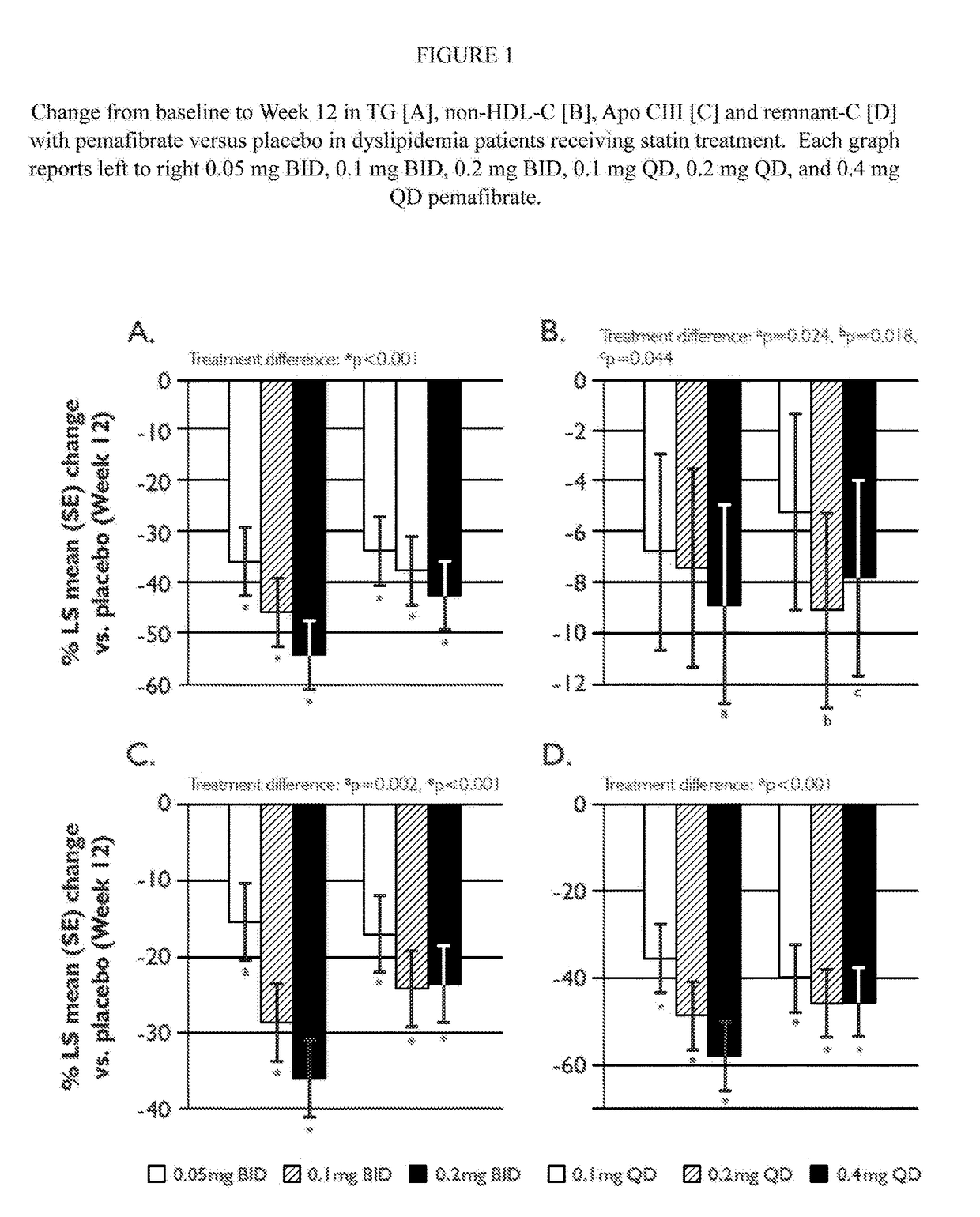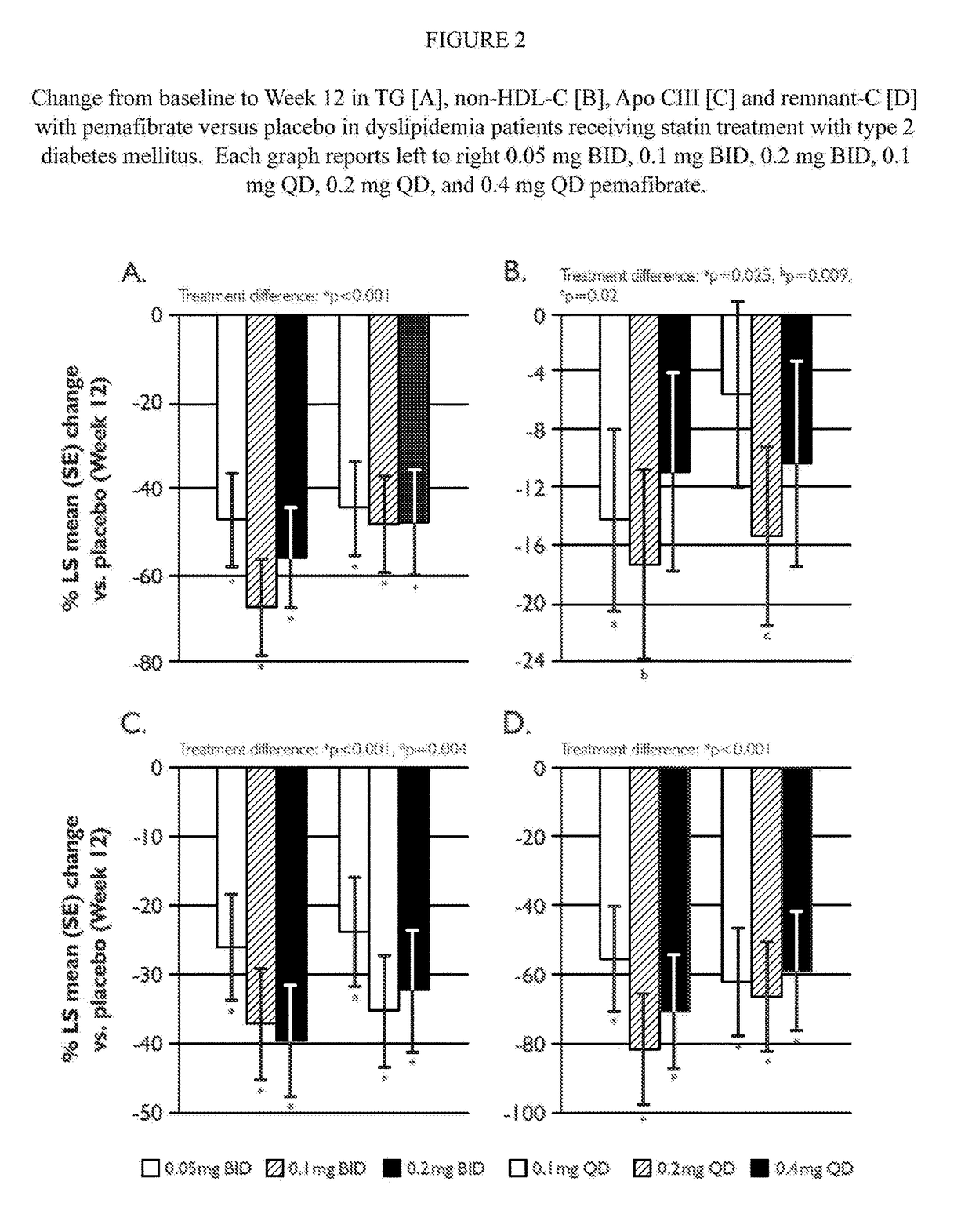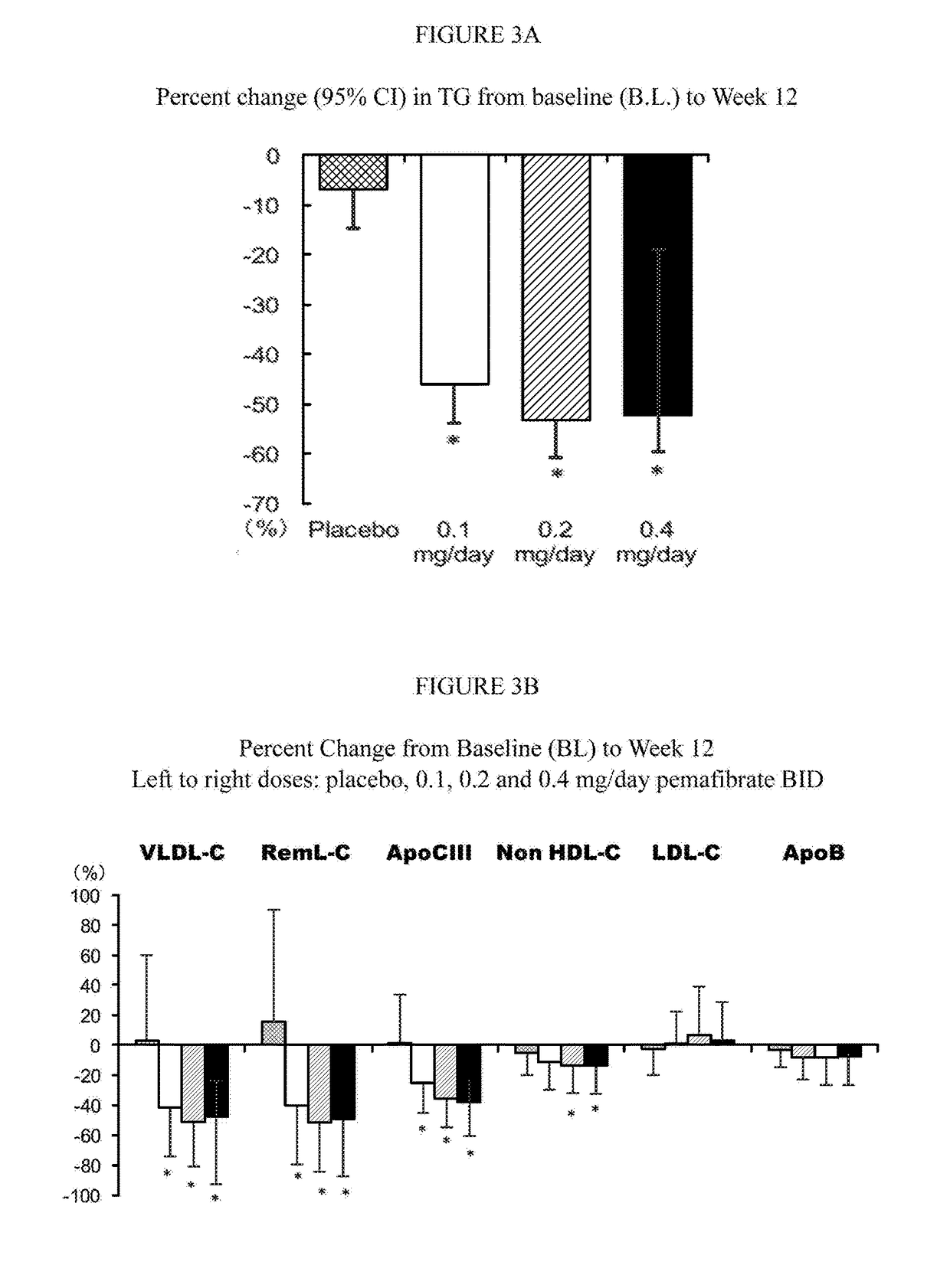Methods of Preventing Cardiovascular Events in Residual Risk Dyslipidemic Populations
a dyslipidemia and residual risk technology, applied in the direction of cardiovascular disorders, drug compositions, metabolic disorders, etc., can solve the problems of one cause of death, one or more of the person's lipid values are associated with an increased risk of cvds, and statins do not completely eliminate all cardiovascular risk, so as to reduce cardiovascular risk, reduce cardiovascular risk, and reduce cardiovascular risk
- Summary
- Abstract
- Description
- Claims
- Application Information
AI Technical Summary
Benefits of technology
Problems solved by technology
Method used
Image
Examples
example 1
Treatment of Dyslipidemia with Pemafibrate as Add-on to Statin Therapy
[0248]A placebo-controlled, randomized, double-blind parallel-group study was performed to evaluate the treatment effect of pemafibrate in dyslipidemia patients on concurrent statin therapy. Dyslipidemia patients on a stable dose of statin therapy (atorvastatin, rosuvastatin or simvastatin) were randomized to one (1) of seven (7) treatment groups: once daily [QD] pemafibrate 0.1 mg, 0.2 mg, or 0.4 mg; twice daily [BID] pemafibrate 0.05 mg, 0.1 mg, or 0.2 mg; or placebo, for 12 weeks of pemafibrate treatment, and were followed for an additional 2 weeks thereafter.
[0249]Patients were required to have statin controlled LDL-C (≦10 mg / dL above the NCEP ATP III target of 100 mg / dL) or on a maximum tolerated dose of statin, but residual dyslipidemia (TG ≧175 and ≦500 mg / dL; HDL-C≦50 mg / dL for male and ≦55 mg / dL for female. Differences in changes of TG, non-HDL-C, Apo CIII, and remnant-C between treatment groups were eval...
example 2
Retrospective Analysis of Type 2 Diabetes Patients
[0258]A post-hoc analysis of patients with type 2 diabetes mellitus (HbA1c≦10%) who participated in the study described in Example 1, was undertaken to determine the treatment effect of pemafibrate in diabetes patients. Overall, 161 type 2 diabetes mellitus patients were randomized and 154 patients completed treatment. 99.4% were white Caucasian, and 35.7% had a history of CHD; intensity of statin therapy was high in 45.5% of patients, moderate in 49.4%. The results of the analysis are reported in FIGS. 2A-2D.
[0259]Tables 1-4 also report the results of the analyses, and compare the results to the results obtained for the general residual dyslipidemia population studied in Example 1.
TABLE 1(TG Reduction Relative to Placebo)Diabetic Residual Dyslipidemia Sub-Population withDosePopulationResidual Dyslipidemia0.05 mg BID−36.1−47.0 0.1 mg BID−45.8−67.4 0.2 mg BID−54.4−56.1 0.1 mg QD−34.0−44.7 0.2 mg QD−37.7−48.1 0.4 mg QD−42.7−47.9
TABLE 2...
example 3
Effectiveness of Pemafibrate as Add-on to Pitavastatin Therapy
[0270]A double-blind parallel-group study was undertaken to determine the effectiveness of pemafibrate when added to an existing statin regimen. A total of 188 patients with fasting high TG (≧200, <1000 mg / dL) and non-HDL-C (≧150 mg / dL), treated with pitavastatin (once daily, 2 mg / day) were randomized to 12-week treatment groups; placebo (n=46), twice-daily pemafibrate 0.1 (n=45), 0.2 (n=49) and 0.4 mg / day (n=48). The primary endpoint was the percentage change in TG from baseline and incidence of adverse drug reactions (ADRs) and adverse events (AEs).
[0271]The results of the study are reported in FIGS. 3A-3D and summarized as follows. Fasting TG reduction was as follows; placebo: −6.9%, pemafibrate 0.1, 0.2 and 0.4 mg: −46.1%, −53.4% and −52.0%. All pemafibrate groups had significant reductions compared with placebo (P<0.001). Fasting non-HDL-C reductions were −5.9% with placebo and −11.3, −14.1 and −13.3% with pemafibrat...
PUM
| Property | Measurement | Unit |
|---|---|---|
| Fraction | aaaaa | aaaaa |
| Fraction | aaaaa | aaaaa |
| Fraction | aaaaa | aaaaa |
Abstract
Description
Claims
Application Information
 Login to View More
Login to View More - R&D
- Intellectual Property
- Life Sciences
- Materials
- Tech Scout
- Unparalleled Data Quality
- Higher Quality Content
- 60% Fewer Hallucinations
Browse by: Latest US Patents, China's latest patents, Technical Efficacy Thesaurus, Application Domain, Technology Topic, Popular Technical Reports.
© 2025 PatSnap. All rights reserved.Legal|Privacy policy|Modern Slavery Act Transparency Statement|Sitemap|About US| Contact US: help@patsnap.com



